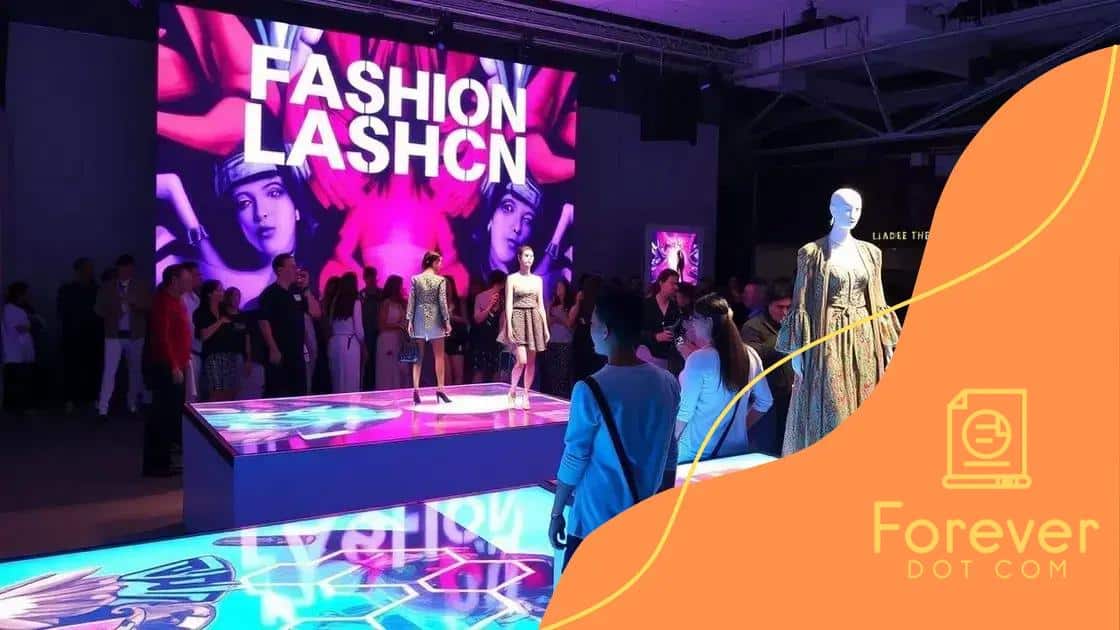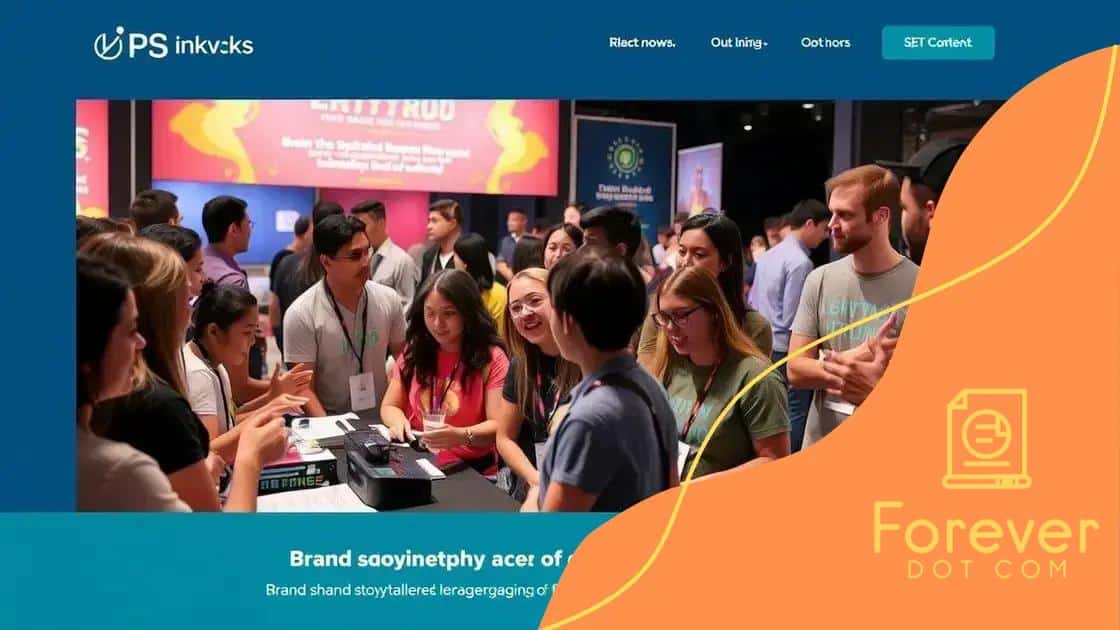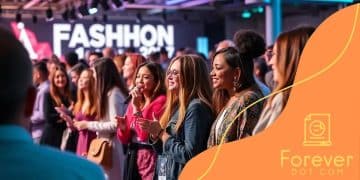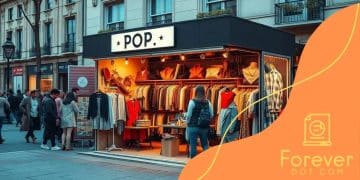Fashion brand launch events with immersive experiences

Fashion brand launch events with immersive experiences leverage technology and social media to engage customers, create memorable interactions, and build lasting brand loyalty through innovative installations and real-time audience participation.
Fashion brand launch events with immersive experiences are not just gatherings; they create unique connections between brands and attendees. Have you ever wondered how these experiences shape our perception of fashion? Let’s dive in!
Setting the stage: The importance of ambiance
Creating the right ambiance is crucial for a successful fashion brand launch event. It sets the mood and reflects the identity of the brand. When guests walk into the venue, they should instantly feel the essence of the brand and its message.
The Role of Colors
Colors play a significant role in shaping the atmosphere. Bright, vibrant hues can evoke excitement, while soft pastels may create a calming vibe. Selecting the right palette can influence the emotional response of attendees.
Lighting Matters
Lighting is another essential element. Bright lights can energize the space, while dim lighting can create an intimate setting. Consider using different lighting options like spotlights, fairy lights, or colored gels to enhance the experience.
- Use spotlights to highlight key products.
- Incorporate fairy lights for a whimsical feel.
- Consider colored lighting to match the brand’s palette.
- Ensure the lighting complements the overall design of the event.
Complementing the visuals with sound can elevate the experience. Music should align with the brand’s image. A high-energy track can pump up the excitement, while mellow tunes can promote conversation.
Finally, don’t overlook the scent. Scents can evoke memories and emotions. Using a signature fragrance can make the event more memorable. It’s all about the sensory experience—creating a holistic approach that engages attendees fully.
Interactive installations that engage the senses
Interactive installations are a fantastic way to engage the senses at a fashion brand launch event. These elements not only attract attention but also allow attendees to connect more deeply with the brand’s story.
Immersive Experiences
Creating immersive experiences can be achieved through various installations. For instance, a virtual reality station lets guests try on clothes virtually. This approach not only entertains but ensures a memorable interaction. Another option is to have tactile displays where guests can feel the fabrics and materials used in new collections.
Engaging All Senses
When designing these installations, incorporating multiple senses is key. Soundscapes can be used to complement visual elements, creating a multi-layered experience. For example, the sound of fabric swishing can be paired with the visual of models walking down a runway. Similarly, including live models to demonstrate clothing can make the experience feel more dynamic and alive.
- Create spaces where guests can touch and interact with products.
- Incorporate scent to evoke feelings related to the brand.
- Utilize technology like augmented reality for unique experiences.
- Design zones that allow guests to express their own style.
Using creative setups, brands can encourage guests to participate actively. This not only promotes products but also fosters meaningful connections. When guests leave the event, the memory of the interactive installations lingers in their minds, enhancing brand recall.
By making events participatory, brands can turn ordinary moments into unforgettable memories. These installations become talking points that attendees will share with friends and followers on social media, expanding the reach of the brand even further.
Experiential marketing: Building brand loyalty

Experiential marketing involves creating memorable events that engage consumers on a personal level. By immersing guests in the brand’s story, companies can foster a strong connection that goes beyond traditional advertising methods.
Creating Meaningful Experiences
To build brand loyalty, it’s essential to create experiences that resonate with audiences. This could involve hands-on activities, interactive displays, or even live performances that align with the brand’s identity. Such activities encourage guests to participate actively, which helps to deepen their relationship with the brand.
Engagement through Storytelling
Storytelling is a powerful tool in experiential marketing. By presenting the brand’s narrative in engaging ways, such as through themed installations or experiences that reflect the brand’s values, guests are more likely to feel a connection. When they engage with a story that they can relate to, they are more likely to develop a sense of loyalty.
- Incorporate personal touches to make guests feel special.
- Utilize social media to amplify experiences.
- Create loyalty programs that reward participation.
- Collect feedback to refine future events and deepen engagement.
Building brand loyalty also involves recognizing and rewarding loyal customers. Events can be a great platform to acknowledge these customers. For instance, offering exclusive access to new products or special discounts during the event can make loyal attendees feel valued. This not only enhances their experience but also encourages them to share their positive feelings with others.
Additionally, leveraging social media during events can amplify the experience. Encouraging attendees to share their experiences online helps create a buzz and encourages others to become part of the community. This broader engagement ultimately drives brand loyalty, as consumers feel like they are part of something greater.
Leveraging technology for immersive experiences
Leveraging technology is essential for creating immersive experiences at fashion brand launch events. By integrating cutting-edge tools, brands can captivate and engage their audience in ways that traditional marketing methods cannot.
Virtual Reality Experiences
Virtual reality (VR) offers a unique opportunity to transport guests to different worlds. With VR headsets, attendees can explore fashion collections in innovative settings, like a virtual runway or a tropical paradise. This technology allows guests to experience garments in motion, offering a broader perspective on how they look and feel.
Augmented Reality Features
Augmented reality (AR) can enhance physical spaces by overlaying digital content onto the real world. This could mean using an app to see how an outfit looks on them without trying it on. AR can also create interactive displays that provide information about fabrics, designers, or the inspiration behind a collection.
- Integrate QR codes for easy access to digital content.
- Use AR for virtual dressing rooms and styling assistance.
- Incorporate gamification elements to engage attendees.
- Provide interactive kiosks that showcase behind-the-scenes content.
Additionally, brands can use social media platforms to create real-time engagement. For example, live streaming events allows followers who cannot attend to participate. Creating unique hashtags can encourage attendees to share their experiences, amplifying the event’s reach. Brands can host contests encouraging attendees to post pictures of their favorite parts of the event using the event’s hashtag, further enhancing the community feeling.
Moreover, utilizing mobile apps can improve the overall experience. Providing attendees with schedules, maps, and access to personalized content helps them navigate the event. Apps can also facilitate instant feedback through polls or surveys, allowing brands to gather insights directly from attendees, which is invaluable for future events.
The impact of social media on event success
The impact of social media on event success cannot be underestimated. It plays a crucial role in promoting fashion brand launch events and creating buzz around them. Brands can reach a wider audience, engage with fans, and foster a sense of community through various platforms.
Pre-Event Promotion
Using social media before the event is vital. Promotional posts can generate excitement. Unique hashtags can encourage followers to share their thoughts and anticipation. Visual content, like teaser videos or behind-the-scenes photos, can also amplify interest, making potential attendees feel involved even before they arrive.
Real-Time Engagement
During the event, social media allows for real-time engagement. Attendees can share their experiences live, which creates a sense of FOMO (fear of missing out) for those unable to attend. This can significantly increase the visibility of the brand and the event.
- Encourage attendees to use a specific hashtag.
- Host live streams of key moments, like fashion shows.
- Post interactive polls or questions to engage online followers.
- Feature user-generated content on official brand pages.
After the event, social media continues its impact. Brands can share highlights, photos, and videos, keeping the momentum alive. This not only showcases the event but also maintains the connection with attendees and followers. A strong social media presence can lead to sustained interest and loyalty.
Moreover, brands can analyze engagement metrics from social media to understand what worked well. This feedback is valuable for planning future events and refining marketing strategies. By leveraging analytics, brands can tailor their approaches to align better with their audience’s preferences and behaviors.
FAQ – Frequently Asked Questions about Fashion Brand Launch Events
How important is social media for fashion events?
Social media is crucial for promoting events, facilitating real-time engagement, and expanding brand visibility.
What role does technology play in enhancing experiences?
Technology, such as VR and AR, helps create immersive experiences that deepen customer engagement and make events memorable.
How can brands build loyalty at launch events?
Brands can build loyalty by creating unique experiences that resonate emotionally and encourage attendees to share their experiences.
What are effective ways to promote an event beforehand?
Using teasers, engaging visuals, and specific hashtags can effectively generate excitement and anticipation among potential attendees.






